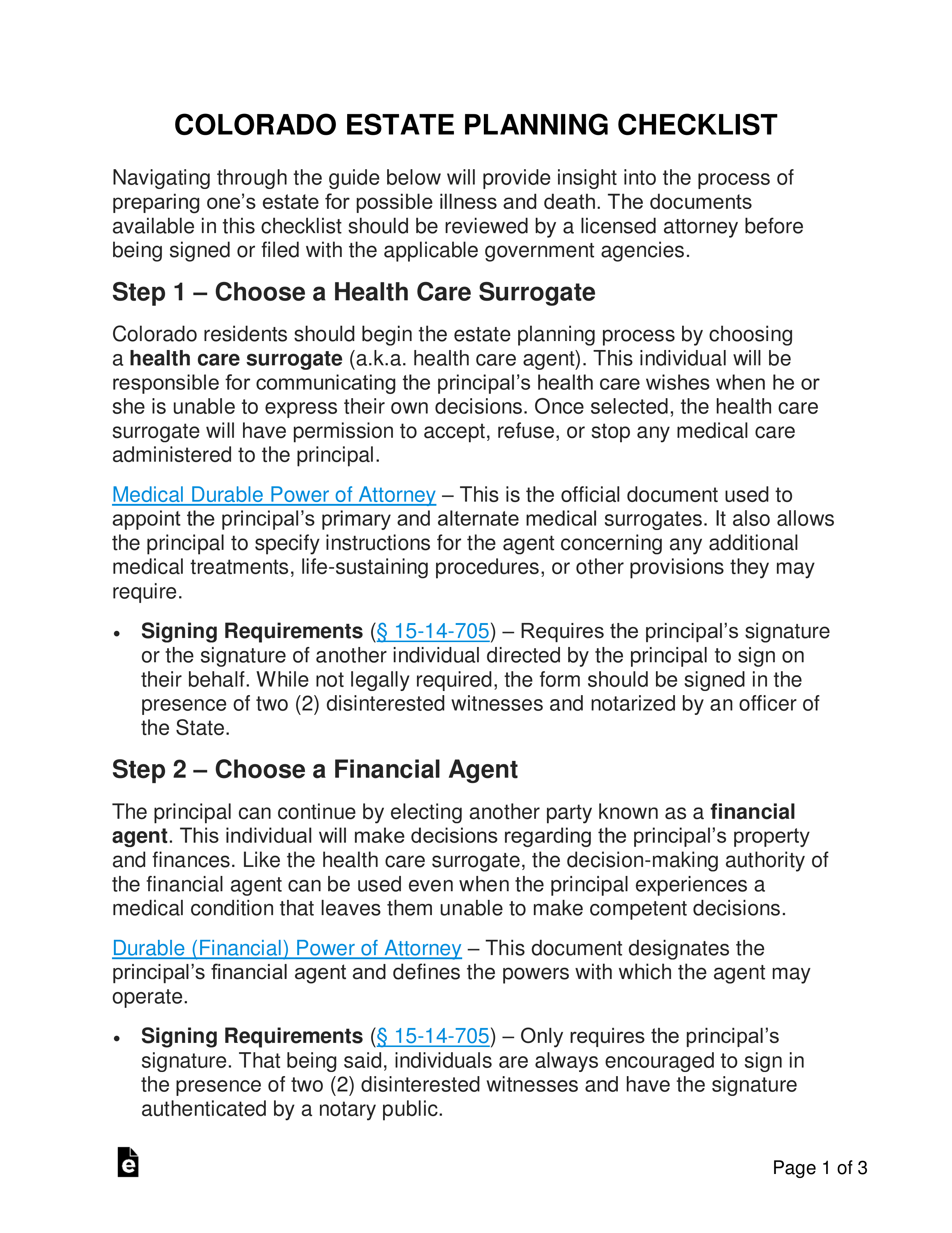Updated March 20, 2024
A Colorado estate planning checklist is a list of useful documents for individuals preparing their estate for death or mental incapacitation. The owner of the estate (the “principal”) can define the health care and financial services they wish to have administered in medical emergencies. Such administrative provisions will be outlined in a Medical Durable Power of Attorney and a Durable (Financial) Power of Attorney. After ensuring the security of their well-being, the principal can determine how their assets will be distributed by completing a Last Will and Testament or a Revocable Living Trust.
How to Create an Estate Plan in Colorado (6 steps)
- Choose a Health Care Surrogate
- Choose a Financial Agent
- Create a List of Assets
- Choose the Beneficiaries and Designate Assets
- Draft an Estate Distribution Document
- Keep the Documents Safe
Navigating through the guide below will provide insight into the process of preparing one’s estate for possible illness and death. The documents available in this checklist should be reviewed by a licensed attorney before being signed or filed with the applicable government agencies.
1. Choose a Health Care Surrogate
Colorado residents should begin the estate planning process by choosing a health care surrogate (a.k.a. health care agent). This individual will be responsible for communicating the principal’s health care wishes when he or she is unable to express their own decisions. Once selected, the health care surrogate will have permission to accept, refuse, or stop any medical care administered to the principal.
Medical Durable Power of Attorney – This is the official document used to appoint the principal’s primary and alternate medical surrogates. It also allows the principal to specify instructions for the agent concerning any additional medical treatments, life-sustaining procedures, or other provisions they may require.
- Signing Requirements – Requires the principal’s signature or the signature of another individual directed by the principal to sign on their behalf. While not legally required, the form should be signed in the presence of two (2) disinterested witnesses and notarized by an officer of the State.[1]
2. Choose a Financial Agent
The principal can continue by electing another party known as a financial agent. This individual will make decisions regarding the principal’s property and finances. Like the health care surrogate, the decision-making authority of the financial agent can be used even when the principal experiences a medical condition that leaves them unable to make competent decisions.
Durable (Financial) Power of Attorney – This document designates the principal’s financial agent and defines the powers with which the agent may operate.
- Signing Requirements – Only requires the principal’s signature. That being said, individuals are always encouraged to sign in the presence of two (2) disinterested witnesses and have the signature authenticated by a notary public.[1]
Financial Powers Allowed
- Real Property[2]
- Tangible Personal Property[3]
- Stocks and Bonds[4]
- Commodities and Options[5]
- Banks and Other Financial Institutions[6]
- Operation of Entity or Business[7]
- Insurance and Annuities[8]
- Estates, Trusts, and Other Beneficial Interests[9]
- Claims and Litigation[10]
- Personal and Family Maintenance[11]
- Benefits From Governmental Programs or Civil or Military Service[12]
- Retirement Plans[13]
- Taxes[14]
3. Create a List of Assets
4. Choose the Beneficiaries and Designate Assets
5. Draft an Estate Distribution Document
One of the most essential steps in ensuring the security of an estate is to create a document that spells out the principal’s preferred method of asset distribution. The following options are available:
Last Will and Testament (‘Will’) – A document which allows the principal to name their beneficiaries and designate the assets to be inherited by each. The Last Will and Testament will be assessed in the probate court before the estate can be transferred to the heirs. During the probate process, court officials will determine whether the Will is valid and whether the value of the principal’s estate must be deducted to cover money owed to creditors.
- Signing Requirements – The principal must sign or direct another individual to sign on their behalf in their presence. Additionally, the document must either be:
- Signed by two (2) or more individuals who witnessed either the principal’s signature or the principal’s acknowledgment of the signature or acknowledgment of the Will; or
- Acknowledged by the principal in the presence of a notarial officer.[15]
Living Trust (Revocable) – This form creates a legal entity that holds possession of the principal’s assets. Whichever assets are placed in the trust may still be managed and benefited from during the principal’s lifetime. As with a Last Will and Testament, a Living Trust allows the principal to name their beneficiaries and specify the assets that each will inherit. Where the two documents differ, however, is that a Living Trust will not be assessed in the probate court. Therefore, the assets held by a Living Trust can be administered immediately following the principal’s death.
6. Keep the Documents Safe
Colorado Estate Planning Laws
- Medical Durable Power of Attorney – § 15-14-506
- Durable (Financial) Power of Attorney – Title 15, Article 14, Part 7
- Last Will and Testament (‘Will’) – Title 15, Article 11
- Revocable Living Trust – Title 15, Article 16


